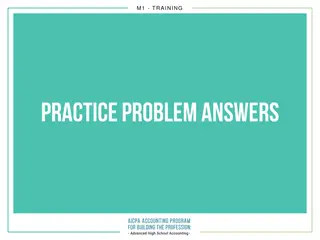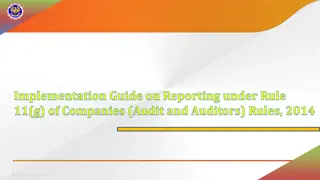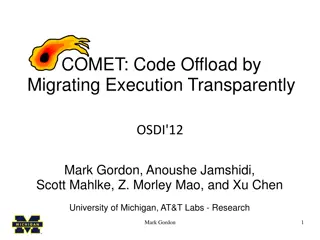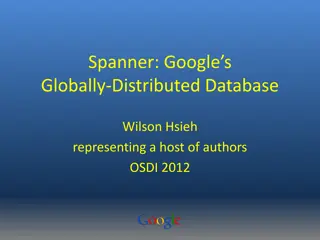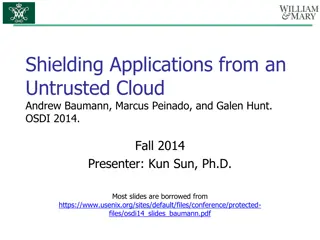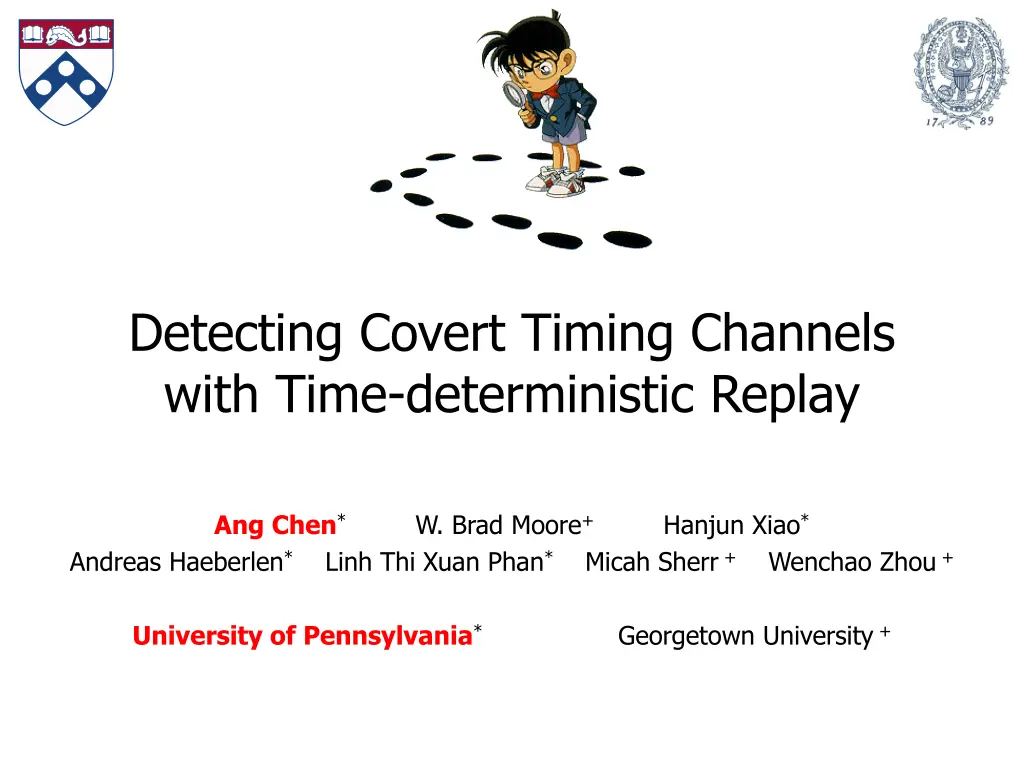
Uncovering Covert Timing Channels with Time-Deterministic Replay
Explore how to detect covert timing channels using time-deterministic replay to compare observed and expected timings, aiding in identifying both known and novel channels. Discover the challenges of predicting expected timings and how deterministic replay can help in reproducing timings for detection.
Download Presentation

Please find below an Image/Link to download the presentation.
The content on the website is provided AS IS for your information and personal use only. It may not be sold, licensed, or shared on other websites without obtaining consent from the author. If you encounter any issues during the download, it is possible that the publisher has removed the file from their server.
You are allowed to download the files provided on this website for personal or commercial use, subject to the condition that they are used lawfully. All files are the property of their respective owners.
The content on the website is provided AS IS for your information and personal use only. It may not be sold, licensed, or shared on other websites without obtaining consent from the author.
E N D
Presentation Transcript
Detecting Covert Timing Channels with Time-deterministic Replay Ang Chen* W. Brad Moore+ Linh Thi Xuan Phan* Hanjun Xiao* Andreas Haeberlen* Micah Sherr+ Wenchao Zhou+ University of Pennsylvania* Georgetown University+
Motivation: Detecting covert timing channels Launch code: 1011 Ah! 1011 President 1 0 1 1 Launch code Code is 1011 H E L L O Attacker Secretary Covert timing channel: Leaks secrets by changing the timing of network outputs 1
State of the art: Statistics-based detection Normal traffic: H E L L O Large gaps Small gaps 1 0 1 1 With channel: H E L L O Distribution of inter-packet delays Current approaches look for specific statistical deviations 2
Problem: Making a new channel is easy! 1 0 0 1 1 Admin ? Needle in a haystack Existing detectors are channel-specific: Using detector A for channel B doesn t work Attacker can always invent a new modulation Low-rate channels ("Needle in a haystack") are hard to detect 3
Is there a different way? Observed Expected Existing approaches detect specific anomalies Our approach: Compare the observed timing to the expected timing Works for covert timing channels in general Can detect both known and unknown/novel channels! But how do we know what timing we should expect? 4
How can we find the expected timing? It would be difficult to predict the timing up front See, e.g., WCET analysis in real-time systems And WCET would only give us an upper bound - but we would need the exact timing! Key insight: We only need to reproduce the timing! We can record the inputs of the machine and then replay them on a different machine! Can we use deterministic replay to do this? 5
Why Deterministic Replay is not enough p3 p2 p1 p3 p2 p1 log log log e1 e2 e1 e2 e3 e3 e1 e2 e3 Deterministic replay records and replays non-deterministic events This reproduces the outputs - but not the timing! 6
Time-deterministic replay (TDR) H E L L O T H E L L O R D Goal: Reproduce both the outputs and the timing With this, we can detect covert timing channels as follows: (1) Reproduce the timing of every network output (2) Compare the observed timing to the reproduced timing (3) Raise the alarm if there is any discrepancy 7
Outline - Motivation - Challenge - Time-deterministic replay (TDR) -Deterministic replay vs. Time-deterministic replay -Time noise, and how to reduce it -Aligning play and replay - Sanity: A TDR prototype -Design & Implementation - Evaluation -Reducing time noise -Aligning play and replay -Detecting timing channels - Conclusion 8
Deterministic Replay is not enough Time during replay (s) Replay is faster Actual 240 200 Ideal 160 Replay is slower 120 80 40 Time during play (s) 0 0 20 40 60 80 100 120 140 160 Experiment: Record and replay an HTTP server in an existing VMM with deterministic replay (XenTT) Result: Play and replay take widely different amounts of time 9
What is causing this discrepancy? There are many different sources of timing variation ("time noise"), such as: Different memory allocations and cache behavior IRQs and system calls take different amounts of time See paper for details Disk accesses take different amounts of time Kernel may interfere with execution or cache content CPU features, such as frequency scaling and speculation Non-deterministic scheduling decisions 10
Example: Controlling time noise from memory Cache Memory var var Problem: Different cache behaviors and memory locations during play and replay. Solution: (1) Manage all memory allocations (2) Flush cache before execution 11
Techniques for mitigating time noise Not all sources of time noise can be eliminated on commodity hardware (e.g., speculation) But we can still achieve a very low noise level 12
Problem: Play and replay have different logic void accessInt(int *value, int *buf) { if (isPlay) *buf = *value; else *value = *buf; } void accessInt(int *value, int *buf) { int temp = (*value) & playMask; temp = temp | (*buf & playMask); *value = *buf = temp; } Same memory access pattern No branches taken Play Replay Play Replay Different memory access patterns Different branches taken Would deterministic hardware, e.g., a PRET machine (Edwards and Lee, 2007), solve all our problems? Problem: Play and replay involve different operations Solution: Carefully design the code to align play and replay 13
Outline - Motivation - Challenge - Time-deterministic replay (TDR) -Deterministic replay vs. Time-deterministic replay -Time noise, and how to reduce it -Aligning play and replay - Sanity: A TDR prototype -Design & Implementation - Evaluation -Reducing time noise -Aligning play and replay -Detecting timing channels - Conclusion 14
Prototype implementation: Sanity Ideal: Implement TDR in an existing VMM, such as Xen But time-determinism is difficult to add to existing codebases Reason: Complex interactions between unrelated functions, e.g., through the cache Our approach: Build a VMM from scratch Chose Java VM because of its simplicity No advanced features yet (e.g., no JIT) Can't expect to compete with Oracle JVM We rely on the Linux kernel for device I/O (e.g., network) Sanity is implemented as a kernel module 15
How Sanity shields itself from the kernel Commands Results Timed core Support core To avoid interference from the kernel, we run the TDR engine on a separate core Limitation: Need two cores to do the work of one 16
Outline - Motivation - Challenge - Time-deterministic replay (TDR) -Deterministic replay vs. Time-deterministic replay -Time noise, and how to reduce it -Aligning play and replay - Sanity: A TDR prototype -Design & Implementation - Evaluation -Reducing time noise -Aligning play and replay -Detecting timing channels - Conclusion 17
Evaluation: Overview Q1: How well can Sanity reduce time noise? Q2: How well can Sanity align play and replay? Q3: How fast is Sanity? Q4: How large is Sanity s log? Q5: How well can Sanity detect covert timing channels? 18
Experimental setup Experiments were run on a Dell Optiplex 9020 workstation (3.4GHz Intel i7-4770 CPU, 16 GB RAM, 128GB Vector ZDO SSD, Linux 3.12) We use two applications: SciMark2 (computation-intensive benchmark) nfsj: Open-source NFS server Baseline: Oracle s SE 7u51 JVM 19
How well can Sanity reduce time noise? Timing Variance (%) 79 Dirty (with GUI and other programs) Clean (single-user mode) 80 Sanity 60 51 44 40 32 32 20 15 16 17 15 1.2 14 1.2 .3 .09 .08 1.2 0 Benchmark SOR SMM MC LU FFT Experiment: Run SciMark2 for 100 times in Oracle s JVM and Sanity Sanity s time-determinism is orders of magnitude better than that of a standard JVM! 20
How well can Sanity reproduce timing? Data points Perfect accuracy 1.85% difference Experiment: Run nfsj and serve 30 files, then replay. Sanity can almost perfectly reproduce the timing of network outputs during replay 21
How well can Sanity detect timing channels? We implemented three known channels: IP covert timing channel (IPCTC) [CBS-CCS 04] Traffic replay covert timing channel (TRCTC) [Cabuk-thesis 06] Model-based covert timing channel (MBCTC) [GWWJ-RAID 08] Plus one new channel: "Needle in a haystack" (worst case for detector) We used four known detectors: Shape test [CBS-CCS 04] KS test [PNR-S&P 06] Regularity test [CBS-CCS 04] Corrected conditional entropy test [GW-CCS 02] Plus our new Sanity-based detector 22
How to measure the quality of a detector Perfect accuracy True positive rate 1 Area under the curve 0 False positive rate 0 1 23
How well can Sanity detect timing channels? 1 1 1 1 Shape test KS test RT test CCE test Sanity 0 0 0 0 TRCTC 0 1 0 1 0 1 IPCTC 0 1 MBCTC Needle Experiment: Run each channel against each detector Observations: All detectors can detect IPCTC with perfect accuracy Existing detectors do worse for more sophisticated channels Existing detectors cannot detect "Needle in a haystack" well Sanity detects all channels with perfect accuracy! (no false positives, no false negatives) 24
Summary Goal:Detect covert timing channels Existing detectors look for signs of specific, known channels Result: "Cat-and-mouse game" with the attacker Our approach: Compare the observed timing to what it 'should be' if the machine is not compromised Works for all timing channels, including novel ones Key challenge: How do we know what the timing should be? We introduce time-deterministic replay (TDR) We have built a TDR prototype called Sanity Reproduces timing to within 2% (on commodity hardware) Can be used to detect a variety of existing and novel covert timing channels with perfect accuracy 25

